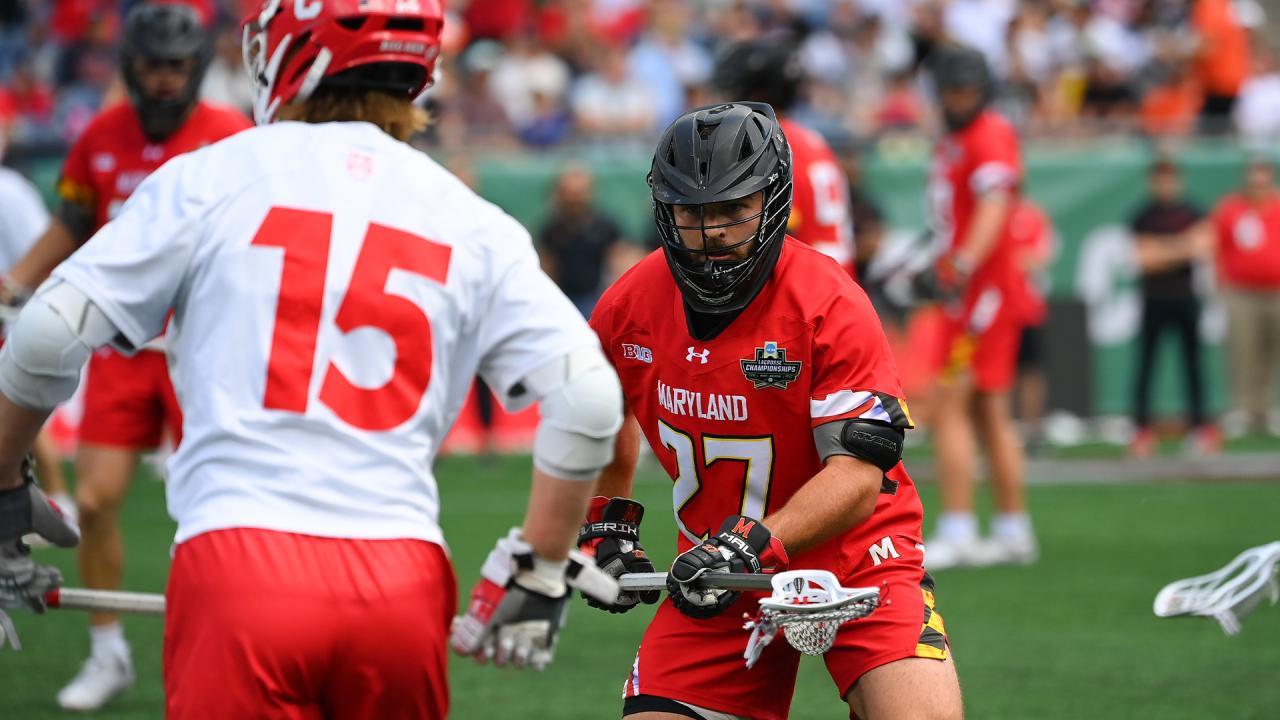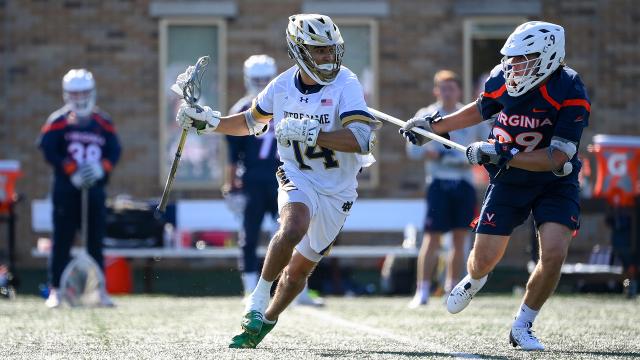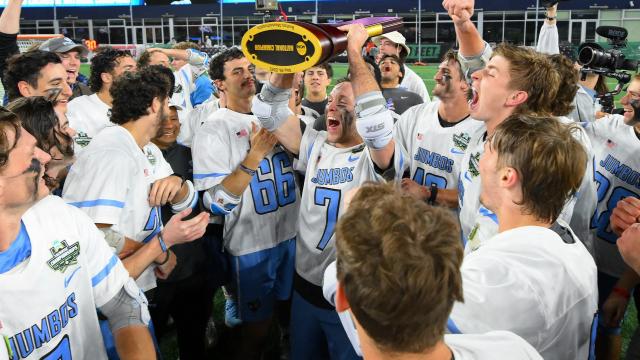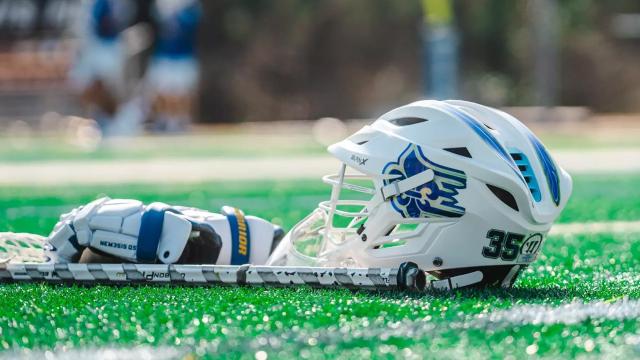
Way-Early 2026 Division I Men's Rankings: 5-1
It's time to wrap up this midsummer lookahead to the 2026 season, and unsurprisingly there are some familiar names — though only one of them has won any of the last eight national titles. Could a lengthy title drought end next spring? Or perhaps there will be a first-time champion?
That won’t be decided for another 318 days — definitely putting the “way-early” in this top 25.
Previously: Nos. 25-21 | Nos. 20-16 | Nos. 15-11 | Nos. 10-6
5. NORTH CAROLINA
2025 record: 10-5 (3-1 ACC)
Last seen: Losing 13-10 at home to Richmond in the program’s first NCAA tournament game since 2021.
Projected starts lost: 42 of 150 (28 percent)
Projected scoring departing: 78 of 288 points (27.1 percent)
Initial forecast: The Tar Heels will deploy about as good a 1-2 attack tandem as there will be in the sport next season with Owen Duffy (34G, 27A) and Dominic Pietramala (48G, 3A). Can they stay healthy — an issue once ACC play arrived last spring — and can they get some help? One candidate to provide it is rising sophomore Mason Szewczyk (9G, 7A), a well-regarded midfielder who had a strong April and entered the starting lineup for the final three games. Another is former Vermont midfielder Charlie Pope, whose 2025 was truncated but produced 42 goals in 2024 to earn the America East’s offensive player of the year nod. And yet another is Anthony Raio, the USA Lacrosse National Player of the Year out of Half Hollow Hills (N.Y.). Carolina’s defense was almost entirely new last season, and a year’s worth of growth coupled with redshirt-sophomore defenseman Peter Thomann’s healthy return should mean a unit that had more good moments than shaky ones is improved. Plus, possession shouldn’t be a problem with Brady Wambach (.643) back to handle faceoffs. The eye-catching exits are mainly last year’s grad transfer crop (goalie Michael Gianforcaro, short stick Andrew O’Berry, midfielder Spencer Wirtheim) and midfield mainstay Ty English (20G, 5A). The Tar Heels were 9-2 last spring before running out of gas. With a little more experience and perhaps a bit more oomph in the midfield, Joe Breschi’s bunch should have a multi-weekend postseason run in it in 2026.
4. GEORGETOWN
2025 record: 12-5 (4-1 Big East)
Last seen: Hanging around into the final 10 minutes of an NCAA quarterfinal against Maryland before falling 9-6.
Projected starts lost: 59 of 170 (34.7 percent)
Projected scoring departing: 175 of 353 points (49.6 percent)
Initial forecast: It may seem a bit daunting for the Hoyas to have to replace their two 60-point scorers — Aidan Carroll (50G, 27A) and Fulton Bayman (31G, 32A) — but Kevin Warne and his staff went out and landed arguably the greatest coup available in the transfer market. Brothers Liam (39G, 51A) and Rory Connor (49G, 33A) arrive after helping Colgate end a decade-long postseason drought, and they’ll join an offense that brings back three of its top five scorers and six of the nine guys who reached double digits in points. It’s a group that includes rising sophomores Jack Ransom (31G, 5A) and Kevin Miller (18G, 10A) and does not include Jack Schubert (13G, 5A in nine games in 2023), who is set to return from injury. Georgetown will have a two-year starter in goal in Anderson Moore (.534SV%), one of the nation’s top defensemen in Ty Banks and a sophomore who started every game in his first season (Robert Plath) also manning the close unit. Faceoff man Ross Prince (.630) also shined as a freshman as the Hoyas won a record seventh consecutive conference tournament. Georgetown doesn’t have nearly as much uncertainty as last season, and with that will come elevated expectations. After four quarterfinal appearances in the last five years, this could be the team that earns the program’s first Memorial Day weekend appearance since 1999.

3. PRINCETON
2025 record: 13-4 (5-1 Ivy)
Last seen: On the losing end of one of the most entertaining NCAA quarterfinals in recent memory, a 19-18 setback against Syracuse that denied the Tigers their second Memorial Day weekend appearance in four years.
Projected starts lost: 57 of 170 (33.5 percent)
Projected scoring departing: 89 of 359 points (24.8 percent)
Initial forecast: While roles are going to adjust with the departure of Princeton career goals leader Coulter Mackesy (44G, 19A in 2025), the Tigers are in remarkably good shape on offense even with a Tewaaraton finalist graduating. Juniors Nate Kabiri (32G, 29A) and Colin Burns (29G, 17A) are both tested options on attack, while Chad Palumbo (28G, 19A) and Tucker Wade (27G, 8A) are both coming off consistent, efficient seasons out of the midfield. Toss in sophomore Peter Buonanno (18G, 11A), who emerged as a threat in the second half of the season, and Princeton will not have problems scoring. But can it get stops when it matters? The Tigers gave up more than 12 goals just five times last year, but four of them were against teams that eventually reached the NCAA semifinals (and they lost all four). Princeton graduated defensemen Michael Bath and Colin Mulshine, but there are still some key figures in place, including goalie Ryan Croddick (.566SV% in his first year as a starter) and short stick Cooper Mueller. Matt Madalon will have a credible, entertaining national title contender, a team with a reasonably high floor and oodles of potential.
2. SYRACUSE
2025 record: 13-6 (2-2 ACC)
Last seen: Paying a steep price for nearly every one of its first-half mistakes in a 14-8 loss to Maryland in the NCAA semifinals.
Projected starts lost: 57 of 190 (30 percent)
Projected scoring departing: 135 of 412 points (32.8 percent)
Initial forecast: Let’s not diminish the Orange’s losses to graduation; attackman Owen Hiltz (46G, 27A), midfielder Sam English (24G, 14A), defenseman Michael Grace and short stick Carter Rice were all on Premier Lacrosse League rosters this summer and were immensely vital figures in the program’s first semifinal appearance since 2013. Nevertheless, Syracuse’s window to win a championship might be open a little wider now that it has some championship weekend experience, and it has a loaded senior class that should be especially incentivized. The Orange have six double-digit scorers back, led by Joey Spallina (35G, 55A), Michael Leo (32G, 12A), Luke Rhoa (27G, 6A) and Finn Thomson (23G, 7A). It brings back one of Division I’s best faceoff men in John Mullen (.630) and a goalie Jimmy McCool (.535SV%), who was superb against ACC competition. That’s a lot to work with coming off a deep run, and it will give Syracuse a chance to win its first national championship since 2009. Is the Orange more consistent in 2026? Does it adopt a title-or-bust attitude — as many of its fans likely will — and deal with the challenges inherent with that approach, or can it take a more narrow, short-term outlook each week? And can it be more buttoned up in the back half of May should the opportunity arise? Syracuse has made steady progress in its first four seasons under Gary Gait. If the Orange takes another step, it will play on Memorial Day.
1. MARYLAND
2025 record: 14-4 (3-2 Big Ten)
Last seen: Falling on the final day of the season for the second year in a row, this time with a 13-10 setback against Cornell.
Projected starts lost: 108 of 180 (60 percent)
Projected scoring departing: 128 of 318 points (40.3 percent)
Initial forecast: There’s a classic disclaimer — past performance is not indicative of future results — that hasn’t really applied to the Terrapins for the last decade or so, and the guess here is they’ll be right back in the national title hunt next season even without the likes of attackman Daniel Kelly (35G, 10A), defenseman Jackson Canfield, goalie Logan McNaney and several other multi-year contributors. Those are serious losses, but Maryland still has Eric Spanos (36G, 19A), Braden Erksa (33G, 15A) and Zach Whittier (14G, 19A) on offense, as well as Will Schaller on close defense, Eric Kolar at short stick and transition weapon AJ Larkin at long pole. McNaney’s injury in 2023 means Maryland gave nearly a full year of starting experience to Brian Ruppel, and he’ll be the favorite to take over between the pipes as a redshirt junior. And then there’s the transfer haul. Leo Johnson (26G, 20A) and Chris Lyons (30G, 11A) arrive from Yale, as does Michael Alexander, who started for nearly three-and-a-half seasons before an injury limited him to five games in 2025. Faceoff ace Henry Dodge (.710) is every bit as much of a prize for the Terps, whose metronomic consistency has produced 11 semifinal appearances in the last 14 tournaments. John Tillman and his staff filled a lot of holes in the portal, and a program that already specializes in even-keel focus should be especially unified in chasing a title after falling a game short the last two Mays.
Patrick Stevens
Patrick Stevens has covered college sports for 25 years. His work also appears in The Washington Post, Blue Ribbon College Basketball Yearbook and other outlets. He's provided coverage of Division I men's lacrosse to USA Lacrosse Magazine since 2010.

Categories
Tags
Related Articles




